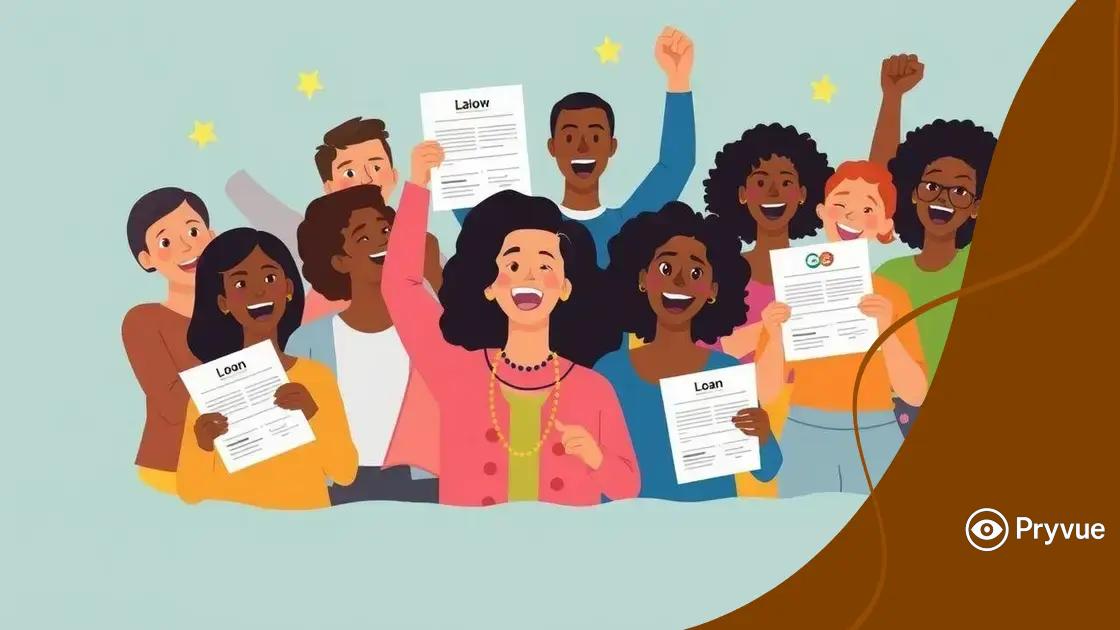Current state of student loan relief in 2025

Anúncios
The current state of student loan relief in 2025 encompasses expanded forgiveness programs, evolving eligibility criteria, and new legislative changes that significantly impact borrowers’ financial options and responsibilities.
The current state of student loan relief in 2025 is evolving, with new policies shaping how borrowers navigate their financial responsibilities. Are you curious about what these changes mean for you? Let’s dive into the details.
Anúncios
Understanding the student loan relief programs
Understanding student loan relief programs is crucial for borrowers navigating their financial responsibilities. These programs aim to ease the burden of debt by offering various options for repayment, forgiveness, and deferment.
Types of Student Loan Relief Programs
There are several key types of relief programs available:
- Income-Driven Repayment Plans: These plans adjust monthly payments based on your income and family size.
- Loan Forgiveness: Programs like Public Service Loan Forgiveness (PSLF) cancel some or all of your debt after a certain period of qualified payments.
- Temporary Relief Options: During economic hardships, borrowers may be eligible for deferment or forbearance.
Many students do not fully understand these options and may miss opportunities for relief. It’s essential to be aware of the eligibility requirements and application processes. For instance, to qualify for forgiveness programs, you often need to work in a public service job for a set number of years while making qualifying payments.
Anúncios
How to Access Relief Programs
To access these programs, you should start by researching your options. Visit the official federal student aid website for detailed guidance. Completing the Free Application for Federal Student Aid (FAFSA) is a necessary step to understand your eligibility.
Keep track of your loans and contact your loan servicer for specifics about your accounts. It’s also beneficial to join support groups where borrowers share tips and experiences regarding loan relief.
Awareness of program changes is vital, especially with recent legislation impacting student loans. Ensuring you stay informed can lead to finding the best options tailored to your situation.
In conclusion, effectively understanding and utilizing student loan relief programs can significantly alleviate financial stress for borrowers. Keeping updated on changes and opportunities can help in making informed decisions about your student debt.
Current eligibility criteria for relief
Understanding the current eligibility criteria for relief is essential for borrowers looking to benefit from student loan programs. Each program has specific requirements that must be met to qualify for relief, and being aware of these can help you make informed decisions about your loans.
Basic Eligibility Requirements
In general, most relief programs require you to meet the following criteria:
- Enroll in a qualifying repayment plan: Many programs require that you are on an income-driven repayment plan to qualify for benefits.
- Document your income: You may need to provide proof of your income to show that you meet the necessary thresholds.
- Be in an eligible job position: For programs like Public Service Loan Forgiveness, your employment must be in a qualifying sector.
Meeting these basic requirements is just the start. Different programs may add specific criteria, such as the type of loans you have or how long you’ve been making payments.
Special Circumstances
Some borrowers may face unique situations that influence their eligibility. For example, if you are facing economic hardship, deferment or forbearance options may be available to you. Additionally, borrowers who consolidate their loans must ensure that they do not lose eligibility for any forgiveness programs.
It’s important to check the details often, as the eligibility criteria can change based on new legislation. Keeping up with the latest information will help you avoid making costly mistakes.
Lastly, always reach out to your loan servicer for personalized information on your eligibility. They can guide you through the options available and help you take advantage of programs that can ease your student loan burden.
Impact of recent legislation on student loans

The impact of recent legislation on student loans has created significant changes that borrowers must understand. Over the past few years, new laws have been introduced that alter the way student loans operate, offering both challenges and opportunities for relief.
Key Legislative Changes
Several key legislative changes have influenced the current landscape:
- Loan Forgiveness Programs: New laws have expanded eligibility for forgiveness programs, allowing more borrowers to qualify for loan cancellation.
- Interest Rate Adjustments: Recent policies may have lowered interest rates, making loans more affordable for future borrowers.
- Streamlined Applications: Legislation has simplified the application process for loan relief, making it easier for borrowers to access benefits.
With these changes, borrowers might find new avenues for reducing their debt. Understanding the specific provisions of these laws is critical to leverage available options.
Considerations for Borrowers
It’s essential to stay informed about how these legislative changes impact individual loan situations. Federal student loans might be affected differently than private loans, so carefully reviewing your loan type is vital. If you are eligible for loan forgiveness, meeting the new criteria can help alleviate your financial burden.
Additionally, following updates from authoritative sources like the Department of Education will ensure that you remain aware of any new developments or changes. Transitioning through these changes can be daunting, but having the right information can empower you.
Overall, the ongoing changes in legislation highlight the importance of being proactive. By being informed, borrowers can make better financial decisions and optimize their options for relief.
Strategies for managing student loan debt
Managing student loan debt effectively requires a combination of strategies that can ease financial stress. Finding the right approach can help borrowers navigate repayment and keep their finances on track.
Develop a Budget
Creating a budget is one of the first steps in managing your finances. By knowing your income and expenses, you can allocate funds for loan payments. This helps ensure you can meet your monthly obligations while still covering your daily needs.
- Track all expenses: Monitor where your money goes each month to identify areas to cut back.
- Avoid unnecessary expenses: Make conscious spending choices to prioritize loan repayment.
- Set realistic payment goals: Use your budget to determine how much you can put toward your loans each month.
With a solid budget, you can gain control over your finances and feel more confident about meeting your repayment obligations.
Consider Repayment Options
Exploring different repayment options can also lead to better management of student loans. Consider switching to an income-driven repayment plan if your financial situation changes. This can lower your monthly payments based on your income. Additionally, consolidation or refinancing your loans could provide lower interest rates or more manageable terms.
Staying in touch with your loan servicer is crucial. They can offer guidance on the options available and help determine what’s best for your circumstances. Regularly reviewing your repayment strategy ensures you are taking advantage of any available benefits or changes in legislation that may affect your loans.
Being proactive about managing your student loan debt can significantly reduce financial stress. Keep informed, budget wisely, and explore all your options to maintain control over your financial future.
Future outlook for student loan relief
The future outlook for student loan relief is an important consideration for borrowers as policies continue to evolve. As new legislation is introduced and economic conditions change, the options available for relief may expand or shift.
Potential Changes in Legislation
Looking ahead, there are several factors that could influence student loan relief:
- Increased Forgiveness Options: Lawmakers are considering expanding current forgiveness programs, potentially allowing more borrowers to qualify.
- Economic Conditions: The economic landscape may shape how relief is provided. A strong economy might lead to loans being managed differently compared to a recession.
- Regulatory Adjustments: Changes in federal regulations could affect interest rates and repayment plans, which may lead to more favorable terms for borrowers.
Awareness of these potential shifts is crucial for borrowers to stay prepared and informed. Keeping up with news and updates in student loan policies will allow individuals to adapt to any changes that may impact their repayment journey.
Importance of Advocacy
As the landscape of student loans evolves, individual borrowers and advocacy groups play a vital role. Staying engaged in discussions about student loan issues can help influence important changes. Advocacy around equitable access to education and fair repayment options is gaining traction.
Engaging with community efforts and understanding how to voice concerns can pave the way for broader reforms. Those affected by student loans should consider participating in these discussions to advocate for their needs.
The ongoing dialogue about student loan relief signifies a commitment to address the challenges borrowers face. By staying informed and involved, individuals can help shape a more favorable future regarding student debt relief options.
FAQ – Frequently Asked Questions about Student Loan Relief
What are the main student loan relief programs available?
The main relief programs include income-driven repayment plans and loan forgiveness options like Public Service Loan Forgiveness (PSLF).
How do I know if I qualify for student loan relief?
Eligibility typically depends on your loan type, employment status, and income level. Reviewing your options with your loan servicer is recommended.
What changes have recent legislation made regarding student loans?
Recent laws have expanded eligibility for loan forgiveness and simplified application processes, making it easier for borrowers to seek relief.
How can I effectively manage my student loan debt?
Create a budget, explore various repayment options, and stay in touch with your loan servicer to make informed decisions about your debt.